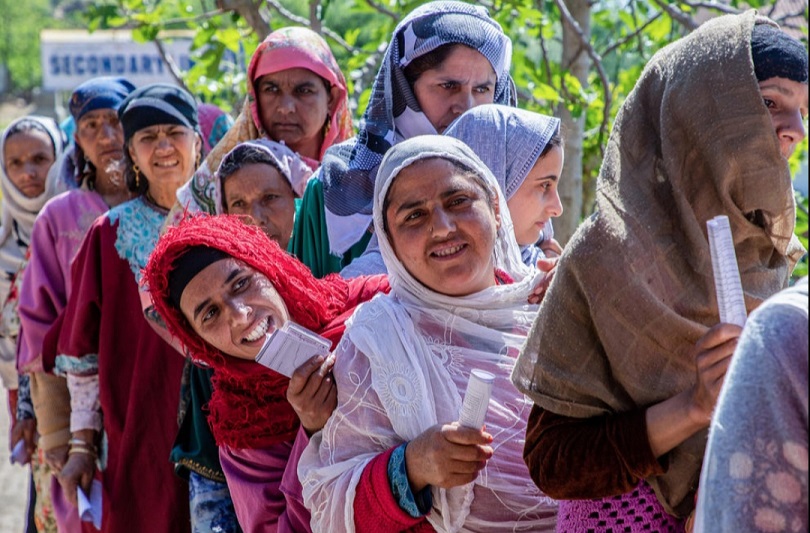
Like the rest of India, the parliament election in Kashmir has not generated a wave in favour of any political party. At the same time, like the BJP at the centre, the National Conference is the favourite party in the Valley to win the majority of seats. But this initial perception has been dented by the intensifying electoral competition as the campaign progresses. The NC now barely holds on to its initial edge in the campaign. For example, in South and Central Kashmir, the PDP president Mehbooba Mufti and Waheed Parra respectively have drawn massive crowds. North Kashmir, on the other hand, has taken an interesting turn: Just as media attention was focussed on the battle royale in the constituency between former J&K Chief Minister Omar Abdullah and People’s Conference chief Sajjad Lone, a wild card entry of the jailed Engineer Rashid has dramatically shifted the dynamics of the electoral race His 23-year-old son, Abrar Rashid, has been running a high-energy campaign on his behalf and attracting large crowds, even in areas that have not traditionally been supportive of his father. All bets are off now.
Though the new political outfits like Apni Party led by Altaf Bukhari and the Democratic Progressive Azad Party (DPAP) are also in the fray, they haven’t made much of a mark so far, more so the latter. And this is telling. Essentially, the ongoing election in Kashmir is a contest between the traditional mainstream political narrative and the new-fangled politics of the past five years.
The old order is represented by the National Conference and the PDP as well as the Congress party, which is a national party though. The BJP’s rise in the former state is a post 2015 phenomenon when for the first time it won 25 of 37 seats from Jammu division in the then Assembly elections. The BJP subsequently formed a coalition government with the PDP which secured 28 seats.
The new order is represented by the Apni Party led by the businessman-turned politician Altaf Bukhari, the DPAP headed by Ghulam Nabi Azad and the People’s Conference (PC) of Sajad Lone. Although the PC is an old party, its new avatar owes itself to the political restructuring of the Valley following the abrogation of Article 370 in August 2019.
Although it is not the Assembly election, the ongoing parliament polls are the first major electoral exercise in which the old and the new political order are face to face. And at the heart of this contest are the two constituencies of Anantnag in South Kashmir where the PDP leader Mehbooba Mufti is the candidate and the North Kashmir’s Kupwara constituency from where the NC has fielded Omar Abdullah. While Mehbooba’s main opponent is the NC’s Mian Altaf, that of Omar is the PC leader Sajad Lone. And, of course, Rashid’s entry has changed the game in Kupwara.
The outcome in these two constituencies will in a limited way be a bellwether for the future Assembly elections. More so in the Kupwara parliamentary constituency where an unlikely win for Lone – or for that matter for Rashid – in a free and fair election would not only be seen as a massive upset but would give a major leg up to either party, otherwise seen as close to the BJP.
Though the NC looks apparently strong and Mehbooba remains politically very much relevant, the parties have a work on hand to retain their centrality. This has become critical after the alliances they were a part of have now decisively come undone. The once-united opposition in the region under the umbrella of INDIA finds itself fractured and scrambling to maintain relevance. This fragmentation, coupled with the BJP’s strategic maneuvering, presents a formidable advantage for the saffron party.
Besides, the unraveling of the Peoples Alliance for Gupkar Declaration (PAGD), reflects the deep-seated divisions within the opposition ranks. Originally formed with the lofty goal of advocating for the restoration of Article 370, the PAGD has devolved into little more than a memory, with its constituent parties failing to even convene, let alone pursue their shared objectives. The NC and the PDP, both integral members of the PAGD, have begun charting independent courses driven by their own political calculations – more so, the NC which was the first to announce candidates for the three parliamentary seats in the Valley.
However, in the evolving political discourse in the Valley, either the PAGD or the INDIA Alliance is of little relevance. What is important is the clash of two narratives – traditional and the new one. The outcome will examine, among other factors, whether the alternative narrative has resonated in Kashmir. Or to put it differently, whether it poses any challenge to established political narratives. As of now, it doesn’t seem to be exactly the case.
- Views expressed in the article are the author’s own and do not necessarily represent the editorial stance of Kashmir Observer
Follow this link to join our WhatsApp group: Join Now
Be Part of Quality Journalism |
Quality journalism takes a lot of time, money and hard work to produce and despite all the hardships we still do it. Our reporters and editors are working overtime in Kashmir and beyond to cover what you care about, break big stories, and expose injustices that can change lives. Today more people are reading Kashmir Observer than ever, but only a handful are paying while advertising revenues are falling fast. |
| ACT NOW |
| MONTHLY | Rs 100 | |
| YEARLY | Rs 1000 | |
| LIFETIME | Rs 10000 | |











